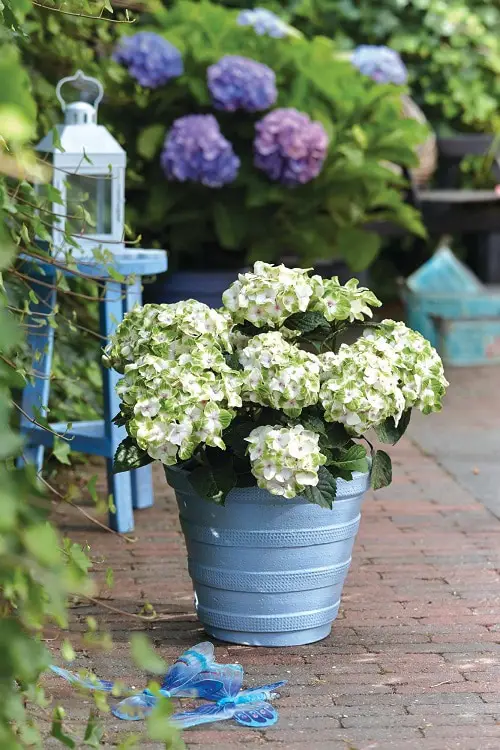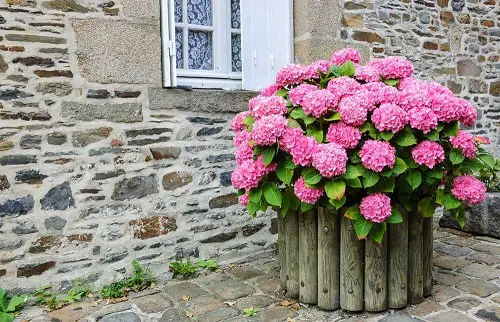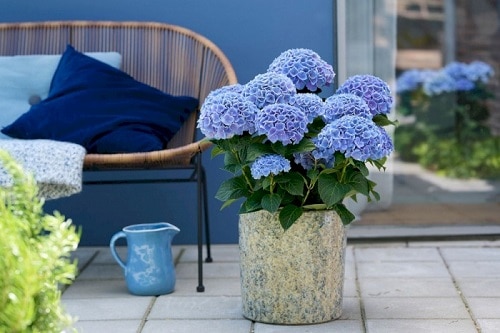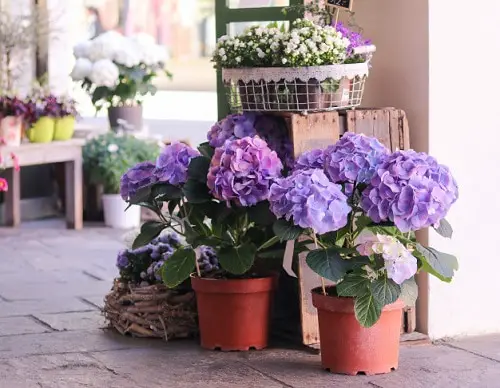Are you looking forward to Growing Hydrangeas in Pots? Here is the complete guide on how you can grow and care for them in the containers!
In recent years, Growing Hydrangeas in Pots has become popular. Flowering from spring to autumn, these flowers come in white, pink, purple, red, and blue, depending upon the variety. You can grow Hydrangea easily indoors or outdoors in containers, with the right combination of soil, water, and sunlight.
Botanical Name: Hydrangea
USDA Zones: 4-10
Soil pH: 4.5-7.5
Check out our article on landscaping with Hydrangeas here
Best Hydrangea Varieties for Pots
Hydrangeas can be great container plants, provided you pick the right variety!
- Hydrangea paniculata ‘Little Lime‘: This variety is hardy to zones 3-8. It flowers from mid-summer till the fall. The color of its blossoms changes naturally from light-green to pink, then finally turning brown, as they fade out.
- Hydrangea macrophylla ‘Mini Penny‘: Hardy to zones 5-10, depending upon the pH of the soil. It produces blue flowers in acidic soil and pink flowers in alkaline soil, from spring to fall.
- Hydrangea paniculata ‘Little Quick Fire‘: This deciduous shrub is hardy to zones 3-8 and produces white flowers during the warmer months, which turn to deep pink later.
- Hydrangea macrophylla ‘Buttons n Bows’: This bigleaf cultivar is hardy to zones 6-8. It has bicolor flowers of pink shade with white lining at the edge of the petals.
Propagating Hydrangeas
From Stem Cuttings
- Choose a young and tender stem and snip off 5-6 inches of cutting, just below the leaf node (growing set of leaves), with a sanitized shear.
- Remove all the leaves from the cutting, except the two sets of leaves at the top of the stem.
- Dip the cutting in a rooting hormone, then place it in an 8-10 inches diameter pot filled with potting soil. Cover it with a plastic bag.
- Keep the soil moist, but not soggy. Keep it away from the direct sunlight.
- New roots will form on a cutting within one-two weeks.
From Seeds
- When the flowering period ends, collect the stem of flowers in a paper bag and let the flower heads die in it.
- After some days, shake the bag and collect the seeds from the flowers.
- During spring, fill 2/3-part of a container (8-10 inches) with perlite potting soil, and water thoroughly to moisten it.
- Sprinkle the seed in the container and cover it with plastic, placing them at a bright location.
- After 10-15 days, the seeds will germinate. Transplant it to a large pot, once it develops some leaves.
Choosing a Container
The container size for hydrangeas depends on the plant size. For nursery bought plants, you can start them in 8-10 inches pot. For large and mature varieties, go for 18-20 inches container. Make sure that it has drainage holes at the bottom. You can also choose containers with wheels as the pots can become quite heavy with all the soil, water and plant.
Here are some pictures of container gardening with hydrangeas
Requirements for Growing Hydrangea in Pots

Sunlight
Depending upon the variety, the sun requirements may differ. For example, Hydrangea paniculata and Hydrangea arborescens like to grow in the morning sun, whereas Hydrangea macrophylla grows best afternoon shade. So, grow potted hydrangeas in the morning sun with afternoon shade.
For indoor hydrangeas, keep them near the south or west-facing window. Avoid growing them in the scorching sun, as it can burn the foliage and blooms, whereas too much shade can result in few blooms.
Tip: If you have kept potted hydrangeas in a sunny balcony, protect them from the afternoon sun by moving them away from the edge of the balcony.
Soil
The soil for growing hydrangeas in pots must be well-draining, and should not be compact. Therefore, choose a potting soil with a high amount of organic material. In the case of Bigleaf hydrangea (Hydrangea macrophylla), you can make changes in the pH of the soil, according to the color of the blooms you want. For blue flowers, make the soil acidic (4.5-5.5 pH) and for pink flowers, make the soil alkaline (more than 6 pH).
Tip: For making the soil alkaline, use lime. Use organic mulch or sulfur to make the soil acidic.
Water
Hydrangeas like moist soil to thrive, hence, require frequent and deep watering. In pots, soil dries out quickly and this water stress can cause foliage shedding. So water them deeply when the topsoil looks dry. Pour it into the pot until it comes out the bottom. Also, make sure that your pot has enough drainage holes to let the excess water drain out because waterlogged soil causes root rot.
Temperature
For growing hydrangeas, the optimum temperature should be around 70 F (21 C) during the day and above 50 F (10 C) in the night. Make sure that the plant is not exposed to the temperature below 40 F (4 C) or else it might die. Bring the pots indoors when the temperature is not suitable. Give them shelter or keep them indoors during summer when the temperature rises above 100 F; as excess heat can cause the plant to droop.
Tip: Protect hydrangeas from strong winds if they are the balcony; it can break their brittle stems.
Hydrangeas Care in Pots

Fertilizer
Hydrangeas should be fertilized in spring and summer, twice a month with a water-soluble, general-purpose fertilizer. Nitrogen promotes leaves growth, phosphorous is for healthy roots and potassium helps in flowering. Apply it according to the instructions printed on the label.
You can also use peat moss and fish emulsion to enrich the soil with organic matter. Avoid over-application of fertilizer, as it will make the plants grow faster with fewer blooms.
Tip: You can also use Epsom salt. Follow the instructions at the label for dosage. Use it at 3 to 5-week intervals to encourage the growth of blossoms.
Pruning & Deadheading
Hydrangeas macrophylla should be pruned when the flowering stops. Prune faded inflorescences till a few centimeters from the base of the stalk. Do not cut shoots with buds in the axils of larger leaves. Other varieties of hydrangea rarely require pruning. But, deadheading should be done, to remove dead blooms. To read more on pruning hydrangeas, check out our article here.
Mulching
You can mulch the soil with chopped leaves, pine straw, and pine bark. It will protect the roots from cold winter, helping to retain moisture. Avoid thick mulching as it can prevent air and water penetration in the soil.
Note: Do not mulch with maple leaves, they can suffocate the plant. Maintain some gap at least 2-inches between the stem and mulch layer.
Pests and Diseases
Diseases like powdery mildew and blister rust cause the leaves of hydrangeas to shed. Also, insects and pests like aphids can affect their growth. You can remove the pests manually or trim out the infected parts to protect them.
Care for Hydrangeas in Pots in Winter
- Protect potted hydrangeas from the harsh cold by bringing them indoors, prior to the first frost. You can also cover the plant with a bubble wrap for added protection in patio or balcony.
- Top us the container with mulch. Use oak leaves, pine needles, or other insulating materials to save roots from cold winter.
- Deciduous Varieties of hydrangeas lose leaves during fall to winter. Prune dead branches during late winter or in early spring.






thank you for the insight into growing Hydrendga in pots I live in an apartment on the 4th floor and have balcony.I am not used to growing things from scratch but would love to give it a go.